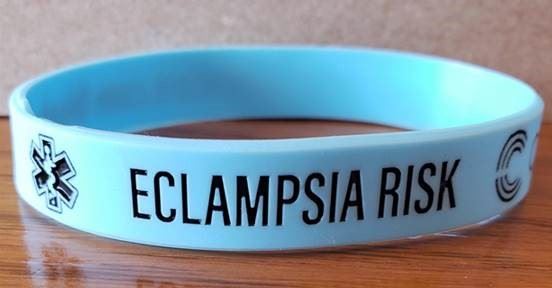High Blood Pressure and Preeclampsia During and After Pregnancy
The
Blue Band Initiative is an effort to alert health care providers about a patient's risk for
preeclampsia. Patients who are at risk will wear a blue wrist band during
pregnancy and after delivery of their babies.
If you have been asked to wear a blue band, keep it on until your provider
takes it off or tells you to take it off.
What is preeclampsia?
Preeclampsia is a serious disorder that can affect many organs (brain, kidneys and/or liver) in your body. Preeclampsia usually happens in the last half of pregnancy. Most often it occurs after 20 weeks. It can also occur up to six weeks after the baby is born.
Preeclampsia can cause:
- High blood pressure
- Protein in the urine
- Organ damage
- Seizure
- Stoke
- Death
Preeclampsia resources for providers:
ACOG Practice Bulletin: Gestational Hypertension and Preeclampsia
Council on Patient Safety in Women's Health Care: Severe Hypertension in Pregnancy
Preeclampsia resources for patients:
National Institutes of Health: Preeclampsia and Eclampsia
Preeclampsia Foundation
Patient story:
Blue Bands Can Save the Lives of Pregnant Women and New Moms
Signs and Symptoms of Preeclampsia
- Swelling of face or hands
- A headache that is severe or will not go away
- Seeing spots or changes in vision
- Pain in the upper right area of your belly
- Nausea or throwing up
- Sudden or rapid weight gain
- Trouble breathing or feeling short of breath
- Heartburn that will not go away
- Decreased urination or none
- High blood pressure
- Chest pain
- Confusion
What are the risk factors for preeclampsia?
- First pregnancy
- A history of preeclampsia in a previous pregnancy
- Family history of preeclampsia
- History of high blood pressure
- History of kidney disease
- Are 35 years or older
- Are carrying more than one baby
- Have certain medical conditions such as diabetes, bleeding disorders, or certain auto-immune conditions
- BMI over 35
- Had fertility treatments
What are the risks for my baby if preeclampsia occurs?
• Premature delivery
• Stillbirth
Long-term risks of preeclampsia
Preeclampsia can cause serious health problems for you and could have lifelong
impacts. Women who have had preeclampsia have increased risk of heart
disease, heart attack and stroke, and high blood pressure.
If you had preeclampsia once, it increases your risk of preeclampsia with future pregnancies.
Wearing a Blue Band
- Leave the blue wristband on until your health care provider takes it off or tells you to take it off.
- Keep your follow-up appointments with your health care provider, even if you are feeling well.
- Expect your first follow-up appointment after delivery to be within 2-5 days of discharge from the hospital.
- Continue your prescribed medications as directed.
If you notice any of the symptoms of preeclampsia listed above, you should seek medical attention. Get a ride to your closest emergency room or call 911 and report the symptoms you have been experiencing.
* It is important to let health care providers know if you are pregnant
or have recently been pregnant.
Many complications of preeclampsia can be prevented. CentraCare is working
to raise awareness of preeclampsia in our communities by using the blue
medical alert bands.